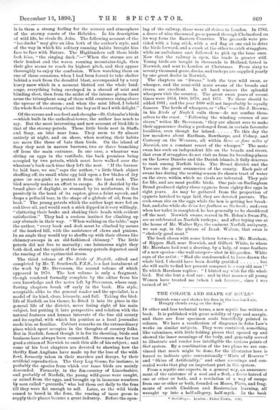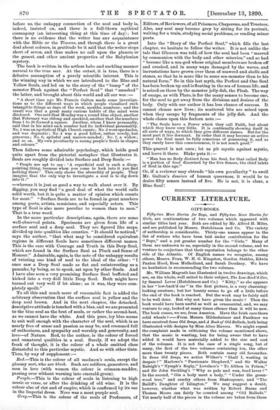THE COLOUR AND SHAPE OF SOULS.*
"Rintrah roars and shakes his fires in the burden'd air, Hungry clouds swag on the deep."
IN other and less technical terms, a new mystic has written a book. It is published with great nobility of type and margin, and there are four specimen souls beautifully printed in colours. We have a recollection of diagrams in John Law's works on similar subjects. They were contrived, something like valentines, with little folding pieces that opened up and showed the inner meanings of the body, and generally served to illustrate and render less intelligible the various points of that system. By a combination of the two plans we are con- vinced that mach might be done, for the illustrator here is forced to indicate quite conventionally " Mists of Reserve " and "Skins of Artificiality," and other coverings and con- cealed works that play an important part in this system.
From a mystic one expects, in a general way, an announce- ment of the existence of a soul and a flesh, a fierce hatred of one or other or both, and a revelation of a way of escape from one or other or both, founded on Moses, Plato, and frag- ments of occult Chaldean and Rosicrucian learning, all wrought up into a half-allegory, half-myth. In the book • Sout-Shares. tendon Fisher tTnyrin. 1480. before us, the unhappy connection of the soul and body is, indeed, insisted on, and there is a full-blown mythical cosmogony (an interesting thing at this time of day) ; but there is no evidence that the writer has any acquaintance with the Bible or the Tim&eus, and though there is a great deal about colours, in gratitude be it said that the writer stops short of seven, and thus makes no call upon the planets or the gamut, and other ancient properties of the Babylonian mystery.
The book is written in the artless babe and suckling manner natural to the true seer. At the outset, it is true, there is a delusive assumption of a purely scientific interest. This is the winning way in which we are introduced to the Blue and Yellow Souls, and led on to the story of the " bump " of the monster Flesh against the "Perfect Soul" that "smashed" the latter, and brought about this world and all our woe :— " A short time ago Mr. Francis Galton made some investiga- tions as to the different ways in which people visualised such intangible things as days of the week, months, numbers ; and the result was that a great many curious habits of the mind were disclosed. One said that Monday was a round blue object, another that February was oblong and speckled, another that the numbers from 1 to 20 formed a square. Another, whom I know personally, said that in his mind each number had its individual personality. No. 1 was an egotistical High Church curate ; No. 2 wore spectacles, and was dogmatic ; No. 4 was a good fellow, rather rowdy, but generous ; No. 6, spiteful and narrow-minded ; No. 7, a widow ; and so on. My own peculiarity is seeing people's Souls in shapes and colours."
Then follows some admirable psychology, which holds good quite apart from the pictorial metaphor that illustrates it. Souls are roughly divided into Surface and Deep Souls :- " People are apt to say : A superficial soul is such a disap- pointing thing, because when you come to look into it you find nothing there.' This only shows the absurdity of people. They imagine that the only way to investigate a soul is to dig down into it :"
—whereas it is just as good a way to walk about over it. By, digging, you may find " a good deal of what the world calls solid worth, but it is quite a matter of opinion which counts
for most." " Surface Souls are to be found in great numbers among poets, artists, musicians, and especially actors. This type of Soul is also more peculiar to women than to men." That is a tree word.
In the more particular descriptions, again, there are some well-observed points. Specimens are given from life of a surface soul and a deep soul. They are figured like maps, divided up into qualities like counties. " It should be noticed," says the author, " that what may be considered equivalent regions in different Souls have sometimes different names.
This is the case with Courage and Truth in this Deep Soul, which are found in the Surface Soul as Pluck and Sense of Honour." Admirable, again, is the note of the unhappy results of twisting one kind of soul to the ideal of the other : " I once saw a Deep Soul made as flat and uninteresting as a pancake, by being, so to speak, sat upon by other Souls. And I have also seen a very promising Surface Soul buffeted and kicked into a very dull little Deep Soul. Both might have turned out very well if let alone ; as it was, they were com- pletely spoilt."
To all this and much more of reasonable fact is added the arbitrary observation that the surface soul is yellow and the deep soul brown. And in the next chapter, the detached, descriptive attitude is touched with a bias, and we are presented to the blue soul as the best of souls, or rather the second-best, as we cannot have the white. And this pure, icy blue seems to suit well enough with the character of the soul, which is as nearly free of sense and passion as may be, and crammed full of enthusiasm, and sympathy and worship and generosity, and love—of Nature. Red, to the author, is the colour of forced and unnatural qualities in a soul. Surely, if we adopt the freak of thought., it is the colour of a whole omitted class distasteful to this particular mystic. And so with other tints. Thus, by way of supplement :— Red.—This is the colour of all madmen's souls, except the gloomy sort, who are black. Such are soldiers, gamesters, and men in love (with women the colour is crimson-madder, passing over without warning into emerald-green).
Purple. —This is the colour of souls in listening to high music or verse, or after the drinking of old wine. It is the colour also of riot and of empire, which is confirmed by its use in the Imperial dress. Nero was a most purple soul.
Grey.—This is the colour of the souls of Professors, of
Editors, of Reviewers, of all Prisoners, Chaperons, and Trustees.
Also, any soul may become grey by sitting for its portrait, waiting for a train, studying social problems, or reading minor poets.
Into the "Story of the Perfect Soul," which fills the last chapter, we hesitate to follow the writer. It is not unlike the tale that Glaucon was told, of how the soul had been "marred by communion with the body and other miseries," and so had " become like a sea-god whose original members are broken off and crushed, and in many ways damaged by the waves, and incrustations have grown over them of seaweed and shells and stones, so that he is more like to some sea-monster than to his natural form." So in this last myth, the Perfect and One Soul has been broken up and is floating in the sea of human life, and is seized on there by the monster jelly-fish, the Flesh. The way of escape, as with Plato, is for the many senses to become one, for the soul to get away from the divisions and desires of the body. Only with our author it has less chance of success. It cannot choose new lives ; its scattered bits are seized upon When they escape by fragments of the jelly-fish. And the whole closes upon this forlorn note :- " The Souls have a Power which they call Faith, but about which they know very little. It is continually showing itself in all sorts of ways, to which they give different names. But for the most part it lies dormant. In order that it may become an active power the Soul must be fully conscious of possessing it, and as they rarely have this consciousness, it is not much good."
This quarrel is not ours ; let us pit mystic against mystic, and leave it there. Blake pats it :—
"Man has no Body distinct from his Soul, for that called Body is a portion of Soul discerned by the five Senses, the chief inlets of Soul in this age."
Or, if a reviewer may obtrude " his own peculiarity " to swell Mr. Galton's dossiers of human queerness, it would be to desire fifty senses instead of five. He is not, it is clear, a Blue Soul !











































 Previous page
Previous page